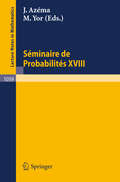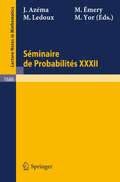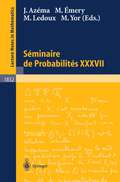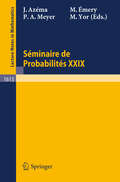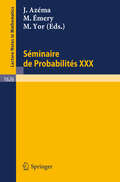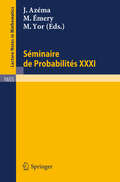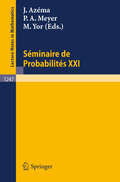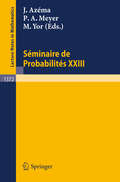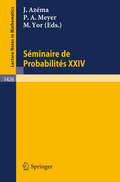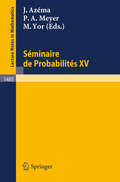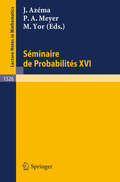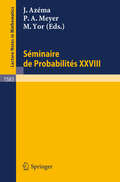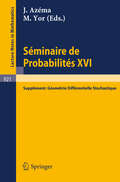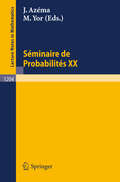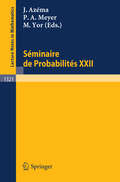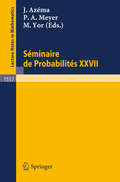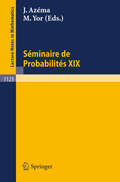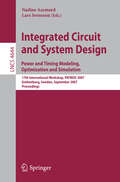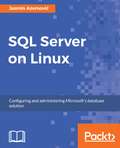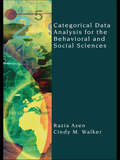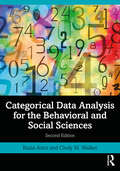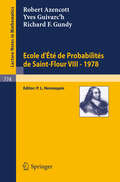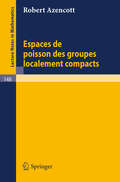- Table View
- List View
Séminaire de Probabilités XVIII 1982/83: Proceedings (Lecture Notes in Mathematics #1059)
by J. Azema M. YorSéminaire de Probabilités XXXII (Lecture Notes in Mathematics #1686)
by Jacques Azema Michel Emery Michel Ledoux Marc YorAll the papers in the volume are original research papers, discussing fundamental properties of stochastic processes. The topics under study (martingales, filtrations, path properties, etc.) represent an important part of the current research performed in 1996-97 by various groups of probabilists in France and abroad.
Séminaire de Probabilités XXXVII (Lecture Notes in Mathematics #1832)
by Jacques Azéma Michel Émery Michel Ledoux Marc YorSeminaire de Probabilites XXIX (Lecture Notes in Mathematics #1613)
by Jacques Azema Michel Emery Paul-Andre Meyer Marc YorAll the papers included in this volume are original research papers. They represent an important part of the work of French probabilists and colleagues with whom they are in close contact throughout the world. The main topics of the papers are martingale and Markov processes studies.
Seminaire de Probabilites XXX (Lecture Notes in Mathematics #1626)
by Jacques Azema Michel Emery Marc YorThe volume consists entirely of research papers, principally in stochastic calculus, martingales, and Brownian motion, and gathers an important part of the works done in the main probability groups in France (Paris, Strasbourg, Toulouse, Besançon, Grenoble,...) together with closely related works done by some probabilists elsewhere (Switzerland, India, Austria,...).
Seminaire de Probabilites XXXI (Lecture Notes in Mathematics #1655)
by Jacques Azema Michel Emery Marc YorThe 31 papers collected here present original research results obtained in 1995-96, on Brownian motion and, more generally, diffusion processes, martingales, Wiener spaces, polymer measures.
Seminaire de Probabilites XXI (Lecture Notes in Mathematics #1247)
by Jacques Azema Paul A. Meyer Marc YorSeminaire de Probabilites XXIII (Lecture Notes in Mathematics #1372)
by Jacques Azema Paul A. Meyer Marc YorBesides a number of papers on classical areas of research in probability such as martingale theory, Malliavin calculus and 2-parameter processes, this new volume of the Séminaire de Probabilités develops the following themes: - chaos representation for some new kinds of martingales, - quantum probability, - branching aspects on Brownian excursions, - Brownian motion on a set of rays.
Seminaire de Probabilites XXIV 1988/89 (Lecture Notes in Mathematics #1426)
by Jacques Azema Paul A. Meyer Marc YorThe different papers contained in this volume are all research papers. The main directions of research which are being developed are: quantum probability, semimartingales and stochastic calculus.
Seminaire de Probabilites XXV (Lecture Notes in Mathematics #1485)
by Jacques Azema Paul A. Meyer Marc YorSeminaire de Probabilites XXVI (Lecture Notes in Mathematics #1526)
by Jacques Azema Paul A. Meyer Marc YorSeminaire de Probabilites XXVIII (Lecture Notes in Mathematics #1583)
by Jacques Azema Paul-Andre Meyer Marc YorIn this volume of original research papers, the main topics discussed relate to the asymptotic windings of planar Brownian motion, structure equations, closure properties of stochastic integrals. The contents of the volume represent an important fraction of research undertaken by French probabilists and their collaborators from abroad during the academic year 1992-1993.
Séminaire de Probabilités XVI 1980/81: Supplément: Géométrie Différentielle Stochastique (Lecture Notes in Mathematics #921)
by Jacques Azéma Marc YorSéminaire de Probabilités XX 1984/85: Proceedings (Lecture Notes in Mathematics #1204)
by Jacques Azema Marc YorSeminaire de Probabilites XXII (Lecture Notes in Mathematics #1321)
by Jaques Azema Paul A. Meyer Marc YorSeminaire de Probabilites XXVII (Lecture Notes in Mathematics #1557)
by Jaques Azema Paul A. Meyer Marc YorThis volume represents a part of the main result obtained by a group of French probabilists, together with the contributions of a number of colleagues, mainly from the USA and Japan. All the papers present new results obtained during the academic year 1991-1992. The main themes of the papers are: quantum probability (P.A. Meyer and S. Attal), stochastic calculus (M. Nagasawa, J.B. Walsh, F. Knight, to name a few authors), fine properties of Brownian motion (Bertoin, Burdzy, Mountford), stochastic differential geometry (Arnaudon, Elworthy), quasi-sure analysis (Lescot, Song, Hirsch). Taken all together, the papers contained in this volume reflect the main directions of the most up-to-date research in probability theory. FROM THE CONTENTS: J.P. Ansal, C. Stricker: Unicite et existence de la loi minimale.- K. Kawazu, H. Tanaka: On the maximum of a diffusion process in a drifted Brownian environment.- P.A. Meyer: Representation de martingales d'operateurs, d'apres Parthasarathy-Sinha.- K. Burdzy: Excursion laws and exceptional points on Brownian paths.- X. Fernique: Convergence en loi de variables aleatoires et de fonctions aleatoires, proprietes de compacite des lois, II.- M. Nagasawa: Principle ofsuperposition and interference of diffusion processes.- F. Knight: Some remarks on mutual windings.- S. Song: Inegalites relatives aux processus d'Ornstein-Ulhenbeck a n-parametres et capacite gaussienne c (n,2).- S. Attal, P.A. Meyer: Interpretation probabiliste et extension des integrales stochastiques non commutatives.- J. Azema, Th. Jeulin, F. Knight,M. Yor: Le theoreme d'arret en une fin d'ensemble previsible.
Seminaire de Probabilites XIX 1983/84: Proceedings (Lecture Notes in Mathematics #1123)
by Jaques Azema Marc YorIntegrated Circuit and System Design. Power and Timing Modeling, Optimization and Simulation: 17th International Workshop, PATMOS 2007, Gothenburg, Sweden, September 3-5, 2007, Proceedings (Lecture Notes in Computer Science #4644)
by Nadine Azemard Lars SvenssonThis volume features the refereed proceedings of the 17th International Workshop on Power and Timing Modeling, Optimization and Simulation. Papers cover high level design, low power design techniques, low power analog circuits, statistical static timing analysis, power modeling and optimization, low power routing optimization, security and asynchronous design, low power applications, modeling and optimization, and more.
SQL Server on Linux
by Jasmin AzemovicBring the performance and security of SQL Server to Linux About This Book • Design and administer your SQL Server solution on the open source Linux platform • Install, configure, and fine-tune your database application for maximum performance • An easy-to-follow guide teaching you how to implement various SQL Server CTP 2.x offerings on Linux—from installation to administration Who This Book Is For This book is for the Linux users who want to learn SQL Server on their favorite Linux distributions. It is not important if you are experienced database user or a beginner as we are starting from scratch. However, it is recommended that you have basic knowledge about relational models. More advanced readers can pick the chapters of their interest and study specific topics immediately. Users from Windows platform can also benefit from this book to expand their frontiers and become equally efficient on both platforms. What You Will Learn • Install and set up SQL Server CTP 2.x on Linux • Create and work with database objects using SQL Server on Linux • Configure and administer SQL Server on Linux-based systems • Create and restore database back-ups • Protect sensitive data using the built-in cryptographic features • Optimize query execution using indexes • Improve query execution time by more than 10x using in-memory OLTP • Track row-versioning using temporal tables In Detail Microsoft's launch of SQL Server on Linux has made SQL Server a truly versatile platform across different operating systems and data-types, both on-premise and on-cloud. This book is your handy guide to setting up and implementing your SQL Server solution on the open source Linux platform. You will start by understanding how SQL Server can be installed on supported and unsupported Linux distributions. Then you will brush up your SQL Server skills by creating and querying database objects and implementing basic administration tasks to support business continuity, including security and performance optimization. This book will also take you beyond the basics and highlight some advanced topics such as in-memory OLTP and temporal tables. By the end of this book, you will be able to recognize and utilize the full potential of setting up an efficient SQL Server database solution in your Linux environment. Style and approach This book follows a step-by-step approach to teach readers the concepts of SQL Server on Linux using the bash command line and SQL programming language trough examples which can easily be adapted and applied in your own solutions.
Categorical Data Analysis for the Behavioral and Social Sciences
by Razia Azen Cindy M. WalkerFeaturing a practical approach with numerous examples, this book focuses on helping the reader develop a conceptual, rather than technical, understanding of categorical methods, making it a much more accessible text than others on the market. The authors cover common categorical analyses and emphasize specific research questions that can be addressed by each analytic procedure so that readers are able to address the research questions they wish to answer. To achieve this goal, the authors: Review the theoretical implications and assumptions underlying each of the procedures Present each concept in general terms and illustrate each with a practical example Demonstrate the analyses using SPSS and SAS and show the interpretation of the results provided by these programs. A "Look Ahead" section at the beginning of each chapter provides an overview of the material covered so that the reader knows what to expect. This is followed by one or more research questions that can be addressed using the procedure(s) covered in the chapter. A theoretical presentation of the material is provided and illustrated using realistic examples from the behavioral and social sciences. To further enhance accessibility, the new procedures introduced in the book are explicitly related to analytic procedures covered in earlier statistics courses, such as ANOVA and linear regression. Throughout each chapter the authors use practical examples to demonstrate how to obtain and interpret statistical output in both SPSS and SAS. Their emphasis on the relationship between the initial research question, the use of the software to carry out the analysis, and the interpretation of the output as it relates to the initial research question, allows readers to easily apply the material to their own research. The data sets for executing chapter examples using SAS Version 9.1.3 and/or IBM SPSS Version 18 are available on a book specific web site. These data sets and syntax allow readers to quickly run the programs and obtain the appropriate output. The book also includes both conceptual and analytic end-of-chapter exercises to assist instructors and students in evaluating the understanding of the material covered in each chapter. This book covers the most commonly used categorical data analysis procedures. It is written for those without an extensive mathematical background, and is ideal for graduate courses in categorical data analysis or cross-classified data analysis taught in departments of psychology, human development & family studies, sociology, education, and business. Researchers in these disciplines interested in applying these procedures to their own research will appreciate this book’s accessible approach.
Categorical Data Analysis for the Behavioral and Social Sciences
by Razia Azen Cindy M. WalkerFeaturing a practical approach with numerous examples, this book focuses on helping the reader develop a conceptual, rather than technical, understanding of categorical methods, making it a much more accessible text than others on the market. The authors cover common categorical analyses and emphasize specific research questions that can be addressed by each analytic procedure so that readers are able to address the research questions they wish to answer. To achieve this goal, the authors: Review the theoretical implications and assumptions underlying each of the procedures Present each concept in general terms and illustrate each with a practical example Demonstrate the analyses using SPSS and SAS and show the interpretation of the results provided by these programs. A "Look Ahead" section at the beginning of each chapter provides an overview of the material covered so that the reader knows what to expect. This is followed by one or more research questions that can be addressed using the procedure(s) covered in the chapter. A theoretical presentation of the material is provided and illustrated using realistic examples from the behavioral and social sciences. To further enhance accessibility, the new procedures introduced in the book are explicitly related to analytic procedures covered in earlier statistics courses, such as ANOVA and linear regression. Throughout each chapter the authors use practical examples to demonstrate how to obtain and interpret statistical output in both SPSS and SAS. Their emphasis on the relationship between the initial research question, the use of the software to carry out the analysis, and the interpretation of the output as it relates to the initial research question, allows readers to easily apply the material to their own research. The data sets for executing chapter examples using SAS Version 9.1.3 and/or IBM SPSS Version 18 are available on a book specific web site. These data sets and syntax allow readers to quickly run the programs and obtain the appropriate output. The book also includes both conceptual and analytic end-of-chapter exercises to assist instructors and students in evaluating the understanding of the material covered in each chapter. This book covers the most commonly used categorical data analysis procedures. It is written for those without an extensive mathematical background, and is ideal for graduate courses in categorical data analysis or cross-classified data analysis taught in departments of psychology, human development & family studies, sociology, education, and business. Researchers in these disciplines interested in applying these procedures to their own research will appreciate this book’s accessible approach.
Categorical Data Analysis for the Behavioral and Social Sciences
by Razia Azen Cindy M. WalkerFeaturing a practical approach with numerous examples, the second edition of Categorical Data Analysis for the Behavioral and Social Sciences focuses on helping the reader develop a conceptual understanding of categorical methods, making it a much more accessible text than others on the market. The authors cover common categorical analysis methods and emphasize specific research questions that can be addressed by each analytic procedure, including how to obtain results using SPSS, SAS, and R, so that readers are able to address the research questions they wish to answer. Each chapter begins with a "Look Ahead" section to highlight key content. This is followed by an in-depth focus and explanation of the relationship between the initial research question, the use of software to perform the analyses, and how to interpret the output substantively. Included at the end of each chapter are a range of software examples and questions to test knowledge. New to the second edition: The addition of R syntax for all analyses and an update of SPSS and SAS syntax. The addition of a new chapter on GLMMs. Clarification of concepts and ideas that graduate students found confusing, including revised problems at the end of the chapters. Written for those without an extensive mathematical background, this book is ideal for a graduate course in categorical data analysis taught in departments of psychology, educational psychology, human development and family studies, sociology, public health, and business. Researchers in these disciplines interested in applying these procedures will also appreciate this book’s accessible approach.
Categorical Data Analysis for the Behavioral and Social Sciences
by Razia Azen Cindy M. WalkerFeaturing a practical approach with numerous examples, the second edition of Categorical Data Analysis for the Behavioral and Social Sciences focuses on helping the reader develop a conceptual understanding of categorical methods, making it a much more accessible text than others on the market. The authors cover common categorical analysis methods and emphasize specific research questions that can be addressed by each analytic procedure, including how to obtain results using SPSS, SAS, and R, so that readers are able to address the research questions they wish to answer. Each chapter begins with a "Look Ahead" section to highlight key content. This is followed by an in-depth focus and explanation of the relationship between the initial research question, the use of software to perform the analyses, and how to interpret the output substantively. Included at the end of each chapter are a range of software examples and questions to test knowledge. New to the second edition: The addition of R syntax for all analyses and an update of SPSS and SAS syntax. The addition of a new chapter on GLMMs. Clarification of concepts and ideas that graduate students found confusing, including revised problems at the end of the chapters. Written for those without an extensive mathematical background, this book is ideal for a graduate course in categorical data analysis taught in departments of psychology, educational psychology, human development and family studies, sociology, public health, and business. Researchers in these disciplines interested in applying these procedures will also appreciate this book’s accessible approach.
